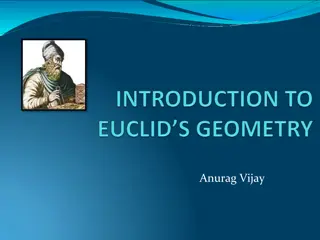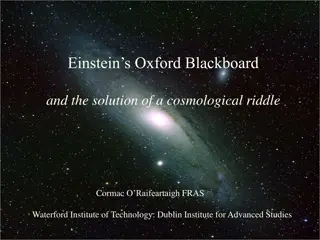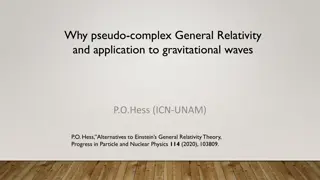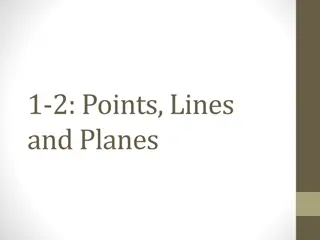Einstein's Achievements in Relativity and Postulates Explained Through Images
Explore Einstein's groundbreaking achievements in the theory of relativity, including the explanation of the precession of Mercury's orbit and gravitational lensing effects. Discover his postulates on the constancy of the speed of light and the distinctions between special and general relativity through a series of informative images.
Download Presentation

Please find below an Image/Link to download the presentation.
The content on the website is provided AS IS for your information and personal use only. It may not be sold, licensed, or shared on other websites without obtaining consent from the author.If you encounter any issues during the download, it is possible that the publisher has removed the file from their server.
You are allowed to download the files provided on this website for personal or commercial use, subject to the condition that they are used lawfully. All files are the property of their respective owners.
The content on the website is provided AS IS for your information and personal use only. It may not be sold, licensed, or shared on other websites without obtaining consent from the author.
E N D
Presentation Transcript
Einsteins Achievements Relativity Explains precession of Mercury s orbit Gravitational bending of light Proven by Eclipse photos in 1920 s Explains gravitational lensing effects observed Cosmological Constant?? Expansion of Universe
http://www.lebanon.k12.mo.us/lhs/faculty/mwhitacre/newton.htmlhttp://www.lebanon.k12.mo.us/lhs/faculty/mwhitacre/newton.html
http://frigg.physastro.mnsu.edu/~eskridge/astr101/kauf24_1a.JPGhttp://frigg.physastro.mnsu.edu/~eskridge/astr101/kauf24_1a.JPG
http://frigg.physastro.mnsu.edu/~eskridge/astr101/kauf24_1b.JPGhttp://frigg.physastro.mnsu.edu/~eskridge/astr101/kauf24_1b.JPG
Einsteins Postulates Theory of Relativity The laws of Physics must have the same form in all inertial reference frames Theory of Constancy for the Speed of Light All Observers measure the same speed of light Another way is c < or = to 2.998 x 108m/s in a vacuum.
Special vs General Relativity 1905 Two frames of reference differ by constant v Train Paradox
http://www.herongyang.com/Physics/Length-Contraction- Reciprocity.html
Special vs General Relativity 1905 Two frames of reference differ by constant v Train Paradox Twin Paradox
https://www- zeuthen.desy.de/exps/physik_begreifen/orlando/time_dilation.html
Special vs General Relativity 1905 Two frames of reference differ by constant v Train Paradox Twin Paradox 1915 Two frames of reference differ by constant a
http://www.physicsoftheuniverse.com/topics_relativity_gravity.htmlhttp://www.physicsoftheuniverse.com/topics_relativity_gravity.html
Special vs General Relativity 1905 Two frames of reference differ by constant v Train Paradox Twin Paradox 1915 Two frames of reference differ by constant a Tidal Forces Theory of Gravity
http://www.nap.edu/html/oneuniverse /images/motion_47.jpg
The central ideas of general relativity have been neatly summarized by the American physicist John Archibald Wheeler. In a now famous phrase Wheeler said: 'Matter tells space how to curve. Space tells matter how to move.' http://physicalworld.org/restless_universe/html/ru_4_24.html
http://thequantumlife.tumblr.com/post/16160919791/gravity- bends-more-than-just-space-it-bends
Test #1 Light bending http://faculty-staff.ou.edu/B/Peter.Barker-1/3023/boardwork3-1.html
http://www-astronomy.mps.ohio- state.edu/~pogge/Ast162/Unit5/bend2.gif
http://science.nasa.gov/headlines/y2004/images/einstein /lensing_med.jpg
http://chandra.harvard.edu/photo/2003/apm08279/apm08279_grav_lens.jpghttp://chandra.harvard.edu/photo/2003/apm08279/apm08279_grav_lens.jpg
http://www.upscale.utoronto.ca/GeneralInterest/Key/ relgen.htm This is one of the first multiply-imaged sources discovered in 1979 (by Walsh, Carswell and Weymann). Points A and B are images of the same distant source (quasar 0957+561), produced by light bending round a closer massive object that produces no image on this photograph.
http://www.upscale.utoronto.ca/GeneralInterest/Key/ relgen.htm This is one of the first so-called 'giant arcs', C12244-02, viewed by the Hubble Space Telescope.
http://www.upscale.utoronto.ca/GeneralInterest/Key/ relgen.htm In this case the foreground galaxy, shown by the bright spot at the centre of the picture is so perfectly aligned with the distant galaxy that the image of the latter becomes an almost perfect Einstein Ring. This picture was taken using the Hubble Space Telescope, by J.L. King, University of Manchester.
http://www.hyperhistory.com/online_n2/people_n2/science_n2/images/keplerlaw.jpghttp://www.hyperhistory.com/online_n2/people_n2/science_n2/images/keplerlaw.jpg
http://www.starryland.com/mailzine/image/071/planet_orbits.jpghttp://www.starryland.com/mailzine/image/071/planet_orbits.jpg
Test #2 Mercurys orbit http://biology-forums.com/index.php?action=gallery;sa=view;id=18683
Test #3 Gravitational Red-Shifts or Gravitational Slowing of time http://scienceblogs.com/startswithabang/2013/01/09/a-though-experiment-for-the-relativity-skeptics/
Test #3 Gravitational Red-Shifts or Gravitational Slowing of time http://slideplayer.com/slide/5682491/
Doppler Red-Shift the radiation is changed (longer wavelength) because of relative motion between the source and the observer. Gravitational Red-Shift the radiation is changed (longer wavelength) because either time or space changes. Doppler Red-Shifts can never indicate motion greater than c Gravitational Red-Shifts can imply motion greater than c but it is because the space or time was changed, not local faster than c travel!!
Test #4 Gravity Waves http://spaceplace.nasa.gov/en/kids/lisa_fact2.shtml The Laser Interferometer (in-ter-fear-AH- muh-ter) Space Antenna (LISA) is a space mission that will be able to detect some of these gravitational waves, like a huge astronomical microphone. If NASA decides to pay for this mission, it will be launched around 2020.























